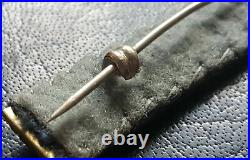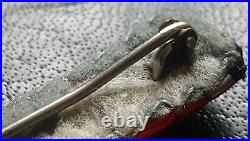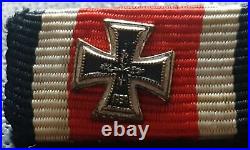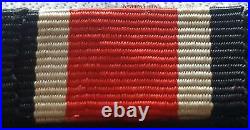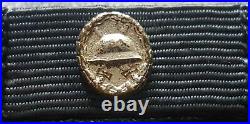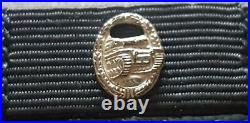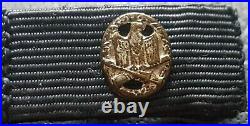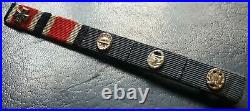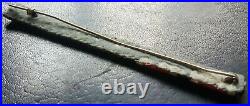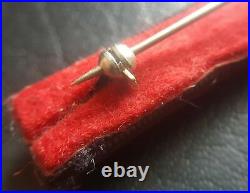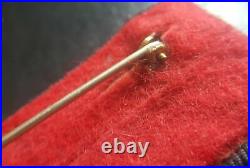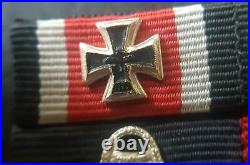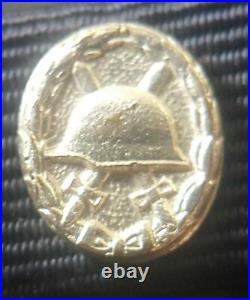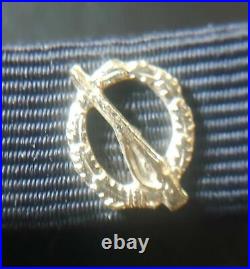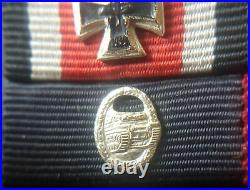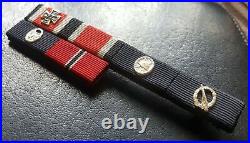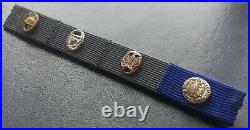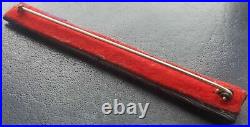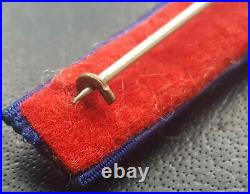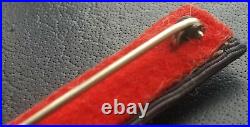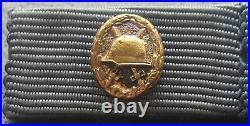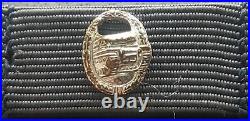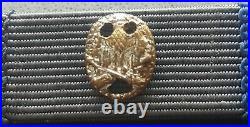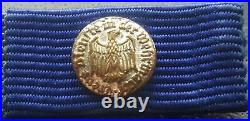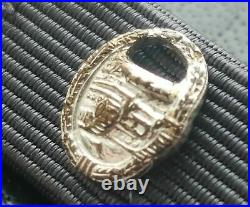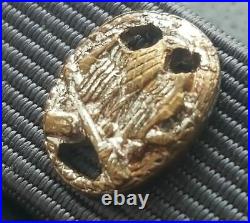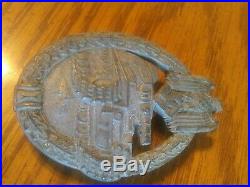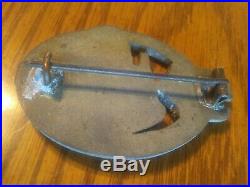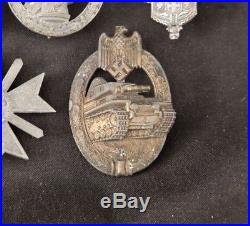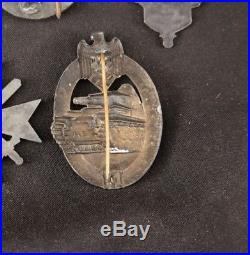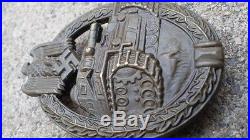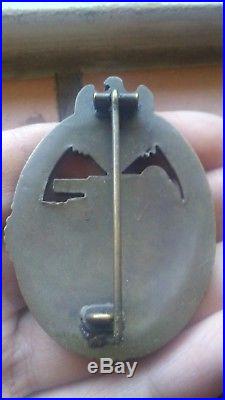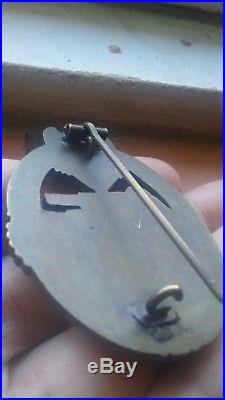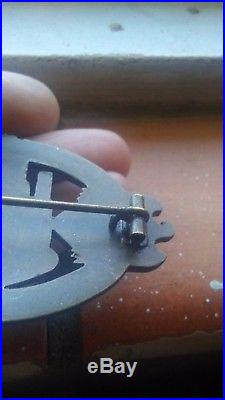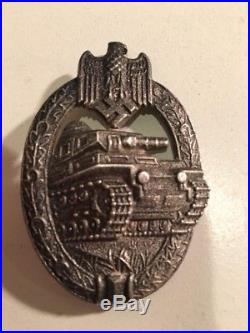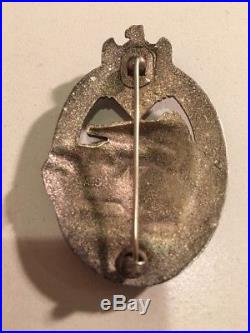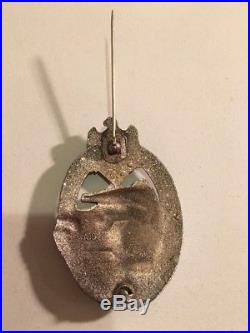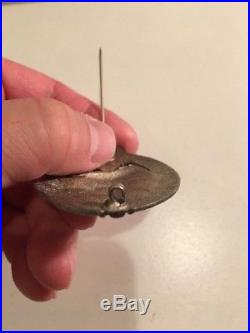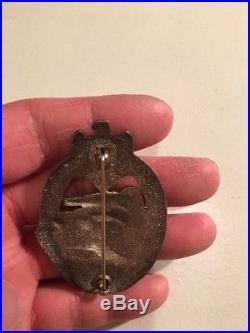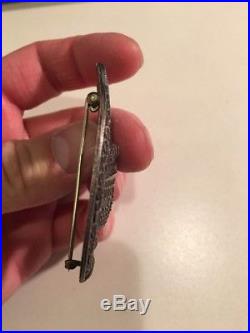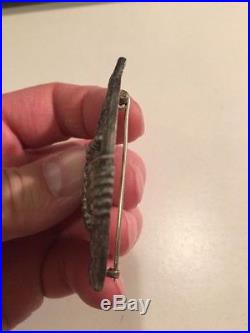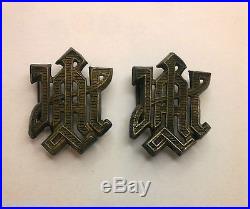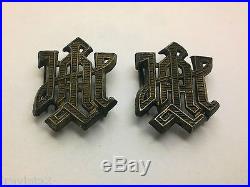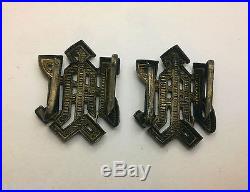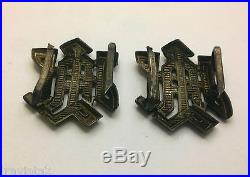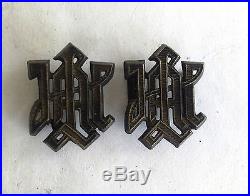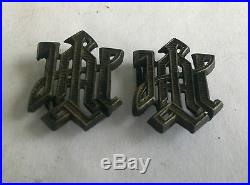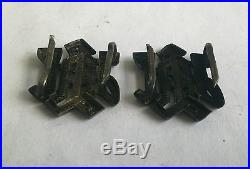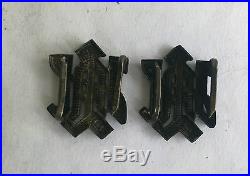- Era: 1945-Present
- Country/ Organization: Germany
- Country/Region of Manufacture: Germany
- Theme: Militaria
- Service: Army
- Conflict: World War II (1939-1945)
- Type: Medals & Ribbons
Posts tagged panzer
Original German post WW2 version / 1957 pattern ribbon bar: Iron Cross First Class, Iron Cross II. Class, Wound Badge in Silver, Panzer Badge in Silver & General Assault Badge, VERY NICE CONDITION, PERFECT PIN DEVICE, ATTRACTIVE & DETAILED MINIATURES. FEW FACTS ABOUT THE 1957 PATTERN AWARDS. In 1957 the West German government authorised replacement Iron Crosses with an Oak Leaf Cluster in place of the swastika, similar to the Iron Crosses of 1813, 1870, and 1914, which could be worn by World War II Iron Cross recipients. The 1957 law also authorised de-Nazified versions of most other World War II-era decorations (except those specifically associated with Nazi Party organizations, such as SS Long Service medals, or with the expansion of the German Reich, such as the medals for the annexation of Austria, the Sudetenland, and the Memel region). The main government contract to manufacture and supply these new de-nazified WW2 1957 official decorations went to the world famous German firm Steinhauer & Lueck, Luedenscheid Germany. Knights Crosses, Iron Crosses, Wound Badges, Tank Assault Badges etc were re-designed by Steinhauer & Lück – often with the oak-leaf spray replacing the swastika, with S&L having the sole patent rights to all WW2 1957 German decorations. S&L did not have the whole monopoly on medal making, other famous firms such as Deschler & Sohn, BH Maher and Juncker also manufactured these new German decorations. Lüdenscheid is situated between the cities Dortmund and Bonn. It was here that one of the youngest medal firms was founded in 1889 by August Steinhauer and Gustav Adolf Lück. The first production began in a cellar, the customer base continued to increase. A property was bought at 51 Hochstrasse which is still home for this famous company today. During WW2 Steinhauer & Lück produced medals and badges, like the famous Knights Cross and many other types of medals and badges. In 1957 this company was awarded the contract to produce all the newly re-designed legal WW2 1957 de-nazified decorations, plus the contract to manufacture all of Germany’s official decorations including Germany’s highest order the Bundesverdienstkreuz. Only a very limited number of original WW2 1957 medals are still produced, mainly Iron Crosses, German Cross Gold & Silver & Wound Badges and are considered 100% genuine by the German Government. HISTORY OF THE AWARD. Iron Cross (German: Eisernes Kreuz) was a military decoration of the Kingdom of Prussia, and later of Germany, which was established by King Friedrich Wilhelm III of Prussia and first awarded on 10 March 1813 in Breslau. In addition to during the Napoleonic Wars, the Iron Cross was awarded during the Franco-German War, the First World War, and the Second World War. The Iron Cross was normally a military decoration only, though there were instances of it being awarded to civilians for performing military functions. Two examples, the civilian pilot Hanna Reitsch was awarded the Iron Cross First Class for her bravery as a test pilot during the Second World War and Melitta Schenk Gräfin von Stauffenberg (also a German female test pilot) was awarded the Iron Cross Second Class. The Iron Cross was also used as the symbol of the German Army from 1871 to 1915, when it was replaced by a simpler Greek cross. In 1956, the Iron Cross became the symbol of the Bundeswehr, the German armed forces. The traditional design is black and this design is used on armored vehicles and aircraft. A newer design in blue and silver is used as the emblem in other contexts. The Iron Cross is a black four-pointed cross with white trim, with the arms widening towards the ends, similar to a cross pattée. It was designed by the neoclassical architect Karl Friedrich Schinkel and reflects the cross borne by the Teutonic Knights in the 14th century. The ribbon for the 1813, 1870 and 1914 Iron Cross (2nd Class) was black with two thin white bands, the colours of Prussia. The noncombatant version of this award had the same medal, but the black and white colours on the ribbon were reversed. Initially the Iron Cross was worn with the blank side out. This did not change until 1838 when the sprig facing could be presented. Since the Iron Cross was issued over several different periods of German history, it was annotated with the year indicating the era in which it was issued. For example, an Iron Cross from the First World War bears the year “1914″, while the same decoration from the Second World War is annotated “1939″. The reverse of the 1870, 1914 and 1939 series of Iron Crosses have the year “1813″ appearing on the lower arm, symbolizing the year the award was created. The 1813 decoration also has the initials “FW” for King Frederick William III, while the next two have a “W” for the respective kaisers, Wilhelm I and Wilhelm II. The final version shows a swastika. It was also possible for a holder of the 1914 Iron Cross to be awarded a second or higher grade of the 1939 Iron Cross. In such cases, a “1939 Clasp” (Spange) would be worn on the original 1914 Iron Cross. A similar award was made in 1914 but was quite rare, since there were few in service who held the 1870 Iron Cross. For the First Class award the Spange appears as an eagle with the date “1939″ that was pinned above the Cross. Although two separate awards, in some cases the holders soldered them together. A cross was the symbol of the Teutonic Knights (a heraldic cross pattée), and the cross design (but not the specific decoration) has been the symbol of Germany’s armed forces (now the Bundeswehr) since 1871. The Iron Cross was founded on 10 March 1813 in Breslau and awarded to soldiers during the Wars of Liberation against Napoleon. It was first awarded to Karl August Ferdinand von Borcke on 21 April 1813. King Wilhelm I of Prussia authorized further awards on 19 July 1870, during the Franco-German War. The Iron Cross was reauthorized by Emperor Wilhelm II on 5 August 1914, at the start of the First World War. During these three periods, the Iron Cross was an award of the Kingdom of Prussia, although given Prussia’s pre-eminent place in the German Empire formed in 1871, it tended to be treated as a generic German decoration. The 1813, 1870, and 1914 Iron Crosses had three grades: Iron Cross 2nd Class German: Eisernes Kreuz 2. Klasse, Iron Cross 1st Class German: Eisernes Kreuz 1. Klasse, Grand Cross of the Iron Cross (German: Großkreuz des Eisernen Kreuzes, often simply Großkreuz). Although the medals of each class were identical, the manner in which each was worn differed. Employing a pin or screw posts on the back of the medal, the Iron Cross First Class was worn on the left side of the recipient’s uniform. The Grand Cross and the Iron Cross Second Class were suspended from different ribbons. The Grand Cross was intended for senior generals of the German Army. An even higher decoration, the Star of the Grand Cross of the Iron Cross, was awarded only twice, to Field Marshal Gebhard von Blücher in 1813 and to Field Marshal Paul von Hindenburg in 1918. A third award was planned for the most successful German general during the Second World War, but was not made after the defeat of Germany in 1945. The Iron Cross 1st Class and the Iron Cross 2nd Class were awarded without regard to rank. One had to already possess the 2nd Class in order to receive the 1st Class (though in some cases both could be awarded simultaneously). The egalitarian nature of this award contrasted with those of most other German states (and indeed many other European monarchies), where military decorations were awarded based on the rank of the recipient. For example, Bavarian officers received various grades of that Kingdom’s Military Merit Order (Militär-Verdienstorden), while enlisted men received various grades of the Military Merit Cross (Militär-Verdienstkreuz). Prussia did have other orders and medals which were awarded on the basis of rank, and even though the Iron Cross was intended to be awarded without regard to rank, officers and NCOs were more likely to receive it than junior enlisted soldiers. In the First World War, approximately four million Iron Crosses of the lower grade (2nd Class) were issued, as well as around 145,000 of the higher grade (1st Class). Exact numbers of awards are not known, since the Prussian archives were destroyed during the Second World War. The multitude of awards reduced the status and reputation of the decoration. Among the holders of the 1914 Iron Cross 2nd Class and 1st Class was Adolf Hitler, who held the rank of Gefreiter. Hitler can be seen wearing the award on his left breast, as was standard, in many photographs. The straight-armed Balkenkreuz, the emblem of the Wehrmacht, first used in a narrower form on Luftstreitkräfte aircraft in mid-April 1918, and as shown here, as it appeared on German planes, tanks, and other vehicles during the Second World War. Wound Badge (German: das Verwundetenabzeichen) was a German military award for wounded or frost-bitten soldiers of Imperial German Army in World War I, the Reichswehr between the wars, and the Wehrmacht, SS and the auxiliary service organizations during the Second World War. After March 1943, due to the increasing number of Allied bombings, it was also awarded to injured civilians. It was ultimately one of the most common of all Third Reich decorations, yet also one of the most highly prized, since it had to be “bought with blood”. The badge had three versions: black (representing Iron), for those wounded once or twice by hostile action (including air raids), or frost-bitten in the line of duty; silver for being wounded three or four times, or suffering loss of a hand, foot or eye from hostile action (also partial loss of hearing), facial disfigurement or brain damage via hostile action; and in gold (which could be awarded posthumously) for five or more times wounded, total blindness, “loss of manhood”, or severe brain damage via hostile action. Badges exist in pressed steel, brass and zinc, as well as some base metal privately commissioned versions. Those of the First World War were also produced in a cutout pattern. All versions of the Wound Badge were worn on the lower left breast of the uniform or tunic. The badge was worn below all other awards on the left. It is thought that more than 5 million were awarded during World War II. In 1957, a revised version of the Wound Badge was authorised for wear; however, the previous type could still be worn if the swastika was removed (for example by grinding). The unaltered Second World War version is shown in the illustration to the right. Wound Badges were primarilly manufactured by the Vienna mint, and by the firm Klein & Quenzer. At first, the Wound badge in Black was stamped from sheet brass, painted semi-matt black, and had a hollow reverse with a needle pin attachment. From 1942, Steel was used to make the badges, which made them prone to rust. The Wound Badge in silver was made (before 1942) from silver-plated brass, and (after 1942) from laquered zinc, and had a solid reverse with either a needle pin or a broad flat pin bar. The Wound Badge in Gold was a gilded version of the Wound Badge in Silver. Heer Panzer Badge (German: Panzerkampfabzeichen) was a German medal awarded to armour troops during World War II. Introduced in World War II in December 1939 (although first introduced during the Great War and another version from the Spanish War). The Tank Combat Badge, or Panzer Badge, first existed in the German Army during World War I, and was later issued again after the Spanish Civil War. The Panzer Badge was introduced on December 20, 1939, in order to recognize the achievements of Panzer personnel who took part in armored assaults. It was designed by Wilhelm Ernst Peekhaus of Berlin, and was instituted by order of Generaloberst Walther von Brauchitsch. On June 6th, 1940, a separate class of the badge, in Bronze, was added in order to recognize the crews of armored vehicles other than tanks. The badge was presented in a paper packet with the name of the award printed on the outside. The award document that was awarded with it was the common type that had the particulars of the recipient (rank, name) and the authorizing signature of an officer. The Panzer Badge was worn on the left tunic pocket. The Bronze Panzer Badge was authorized for armored personnel and Panzer-Grenadier units equipped with armored vehicles. It was also to be presented to members of armored reconnaissance groups and rifle battalions of Panzer divisions. The authorization of these badges was usually done at a regimental or divisional level. The Panzer Badge consists of an oval with a wreath composed of five single oak leaves on one side and four on the other (the tank treads cover one). At the base of the oval is a tie, and on top is the Wehrmacht eagle, which has downspread wings and is clutching a swastika in its talons. In the center of the badge is a tank that passes from left to right. The left track of the tank goes into the wreath of oak leaves, and the area under the tank is grooved and made to look like grass. The reverse of the badge has three variations, the badge could either be hollow backed, flat, or semi-dished. The hollowed backed variation showed the imprint of the obverse, while the flat was just solid (pictured here). The semi-dished version has a slight indent that shows part of the outline of the tank. The badge was attached to the uniform via a hitch and hook, which were affixed to the reverse and had a couple was the conventional soldering of a small rectangular medal bar (pictured here), as well as the more rare type in which a circular ball hinge was inserted into the body of the badge. The tank in the center of the medal is a Panzerkampfwagen IV. Silver Panzer Badge criteria were, to have taken part in 3 armored assaults on 3 different days, to have been wounded in an assault, to have won a decoration for bravery in an assault. The Silver class was presented to tank commanders, gunners or radio operators while the bronze class was presented to the Panzer-Grenadier regiments, tank assault crew, armored recon units, and medical personnel who went into battle in armored vehicles. The award was authorized through the Panzer Division commander. As the war continued it became apparent that the single Panzer Badge was no longer adequate to recognize the growing number of veterans with years of experience, and in June of 1943 four new classes of the award were introduced for 25, 50, 75 and 100 engagements. These new badges consisted of an award that was similar to the unnumbered Panzer Badge, but with a box showing the Arabic number of the class at the base of the wreath. The badge was slightly larger for the 25 and 50 type with the 75 and 100 being larger still. The wreath in the case of the 25 and 50 was silvered, while in the 75 and 100 class it was gilt. The center of the badge (the tank) was made of a separate striking and chemically darkened in the case of the 25 and 50 class, while in the 75 and 100 class the tank was silvered. The reverse has several variations, and could either have a slim or wide pin. The 50 and 100 engagement badges were struck in a in a lightweight zinc alloy, this was so that the larger pin did not pull inconveniently on the tunic. The 200 engagements badge was unofficially created and was never officially documented. The Tank in the center of the medal is a Panzerkampfwagen III. The 1957 de-Nazified version lost the Eagle and the Swastika, but was otherwise unchanged. On November 3, 1944 Reichsmarshall Hermann Göring instituted the Luftwaffe Panzer Badge, to honor the panzer troops of the Luftwaffe field divisions. Until this time qualified Luftwaffe personnel were awarded the Panzer Badge. The order called for two basic forms of the badge. The first style consisted of silver oak leaf wreath and Luftwaffe flying eagle with a black tank in the center. These badges were awarded to tank commanders, gunners, drivers, radiomen, repair crews and their medical personnel. The second style was identical to the first except the oak leaf wreath was now black. Panzer grenadiers, armored reconnaissance units, and the medical personnel attached to them were all eligible for this style. The Luftwaffe Panzer Badge consists of an oval wreath composed of eight oak leaves on the left and, due to the tank protruding from the center, only seven oak leaves on the right. A ribbon is positioned on the base of the wreath and a Luftwaffe flying eagle is to be found at the top. The award document that was to be awarded with it was the common type featuring the recipients name, rank, unit, and the authorizing signature of an officer. The Luftwaffe Panzer Badge was worn on the left pocket of the tunic and (as with all badges) could be worn on civilian clothes in miniature stickpin form. Both badge styles were awarded for three combat engagements on three different days. As mentioned above the silver wreathed versions were awarded to panzer crews, repair crews, and the medical personnel attached to them, while the black wreathed version was awarded to panzer grenadiers, armored recon units, and their medical personnel. General Assault Badge – General von Brauchitsch instituted the General Assault Badge on January 1st, 1940. The badge, designed by the firm of Ernst Peekhaus of Berlin, was to be awarded to those German soldiers who participated in infantry attacks but were not part of infantry units and therefore did not quality for the Infantry Assault Badge. The General Assault Badge consisted of an oval disk that measured 53mm by 42mm and was 6mm wide. The disk had raised edges and fine pebbling in the background, with and wreath of oak leaves made of 5 parts laid on each side. This oak leave wreath begins at two acorns located at the base of the badge. The protruding stick grenade and bayonet separate the first two wreaths, while acorns fill the last two separations. The center feature consists of a Wehrmacht Eagle clutching a swastika in its talons. The eagle surmounts a crossed bayonet and a stick grenade, which as mentioned above protruded into the oval disk. The reverse may either be solid or hollow, with a pin and catch serving as the devise that held the badge to the uniform. As with most badges the quality of detail in the General Assault Badge is mostly standard, but the quality of materials was not always the same and as a result some of the badges have lost their finish with the passing of time, yielding a gray appearance. For more information on the construction of the General Assault Badge please see the Badge Construction Technique page. The award was most often presented in plain paper packets, that varied in colors, with the name of the award printed on the outside, or in a simple cellophane packet. As with most badges, the General Assault Badge was worn on the left breast pocket of the tunic as badge was presented with an award document that had the details of the recipient, but no official mention of the deed that earned the award. The General Assault badge was presented to engineers (who it was originally designed for), as well as members of the artillery, anti-tank, and anti-aircraft units that served along with the infantry in the conduct of an assault. Also eligible were medical personnel who treated battlefield wounded. In addition, the badge was presented for the single-handed destruction of eight tanks or armored vehicles until the institution (in March of 1942) of The Special Badge for Single Handed Destruction of a Tank. Specific criteria was as follows: the recipient must not be eligible for the Infantry Assault Badge, to have taken part in three infantry or armored assaults on three different days, to have taken part in three infantry or armored indirect assaults on three different days, to have been wounded while fulfilling the second or third requirement, to have earned a decoration while fulfilling the second or third requirement. As the war went on, the high command recognized the need for a higher grade of this decoration to be presented to the increasing number of seasoned veterans, and on June 6th 1943, four new grades were introduced. The badge would now be presented to veterans in 25, 50, 75 and 100 classes. The first two are rare but attainable, meaning that they come for sale at regular dealers from time to time, while the latter two are rare in the extreme. The 25 and 50 badge were similar in style, design and construction. They consisted of an oval wreath of oak leaves similar to the unnumbered badge but larger, measuring 58mm by 48mm with a width of 7mm. At the base of the oval is a box, measuring 10mm by 8mm, with another box measuring 8mm by 6 mm inside of it. In the smaller box was the Arabic number “25″ or “50″, depending of course on the grade. The central design was blackened, while the wreath was silvered. The central motive was again the eagle clutching a swastika on its talons, surmounting a crossed grenade and bayonet. This center design has a black oxidized finish, and was from a different striking which was held on the oval by way of four ball rivets. These badges were slightly different than the ones described this case, the oak leaves wreaths constituted the inner and outer edge of the oval that measured 56mm by 49mm, and was 7.5mm in width. The box at the base of the circle measured 10mm by 8mm, but the inner box measured 9mm by 7mm, a slight e the box were the numbers “75″ or “100″, depending on the grade. The central design was the familiar eagle clutching the swastika surmounting the bayonet and grenade. In this case the eagle is slightly larger, and the bayonet and grenade are crossed at a different angle. The central design was blackened, while the wreath was in this case gilded. The eagle and bayonet/grenade are secured onto the oval by four rivets. The numbered awards had the same criteria as the single badge, and was presented in progressive order as the veterans gained more experience. There was retrospective credit given for service in Russia accumulated as follows, eight months service equaled 10 actions, twelve months service equaled 15 actions, fifteen months service equaled 25 actions. This item is in the category “Collectables\Militaria\World War II (1939-1945)\Medals/ Ribbons”. The seller is “a..anderson” and is located in this country: GB. This item can be shipped worldwide.
Original German post WW2 version / 1957 pattern ribbon bar: Iron Cross First Class, Iron Cross II. Class, Wound Badge in Silver, Infantry Assault Badge in Silver, Panzer Badge in Silver & Eastern Front Medal, VERY NICE CONDITION, PERFECT PIN DEVICE, ATTRACTIVE & DETAILED MINIATURES. FEW FACTS ABOUT THE 1957 PATTERN AWARDS. In 1957 the West German government authorised replacement Iron Crosses with an Oak Leaf Cluster in place of the swastika, similar to the Iron Crosses of 1813, 1870, and 1914, which could be worn by World War II Iron Cross recipients. The 1957 law also authorised de-Nazified versions of most other World War II-era decorations (except those specifically associated with Nazi Party organizations, such as SS Long Service medals, or with the expansion of the German Reich, such as the medals for the annexation of Austria, the Sudetenland, and the Memel region). The main government contract to manufacture and supply these new de-nazified WW2 1957 official decorations went to the world famous German firm Steinhauer & Lueck, Luedenscheid Germany. Knights Crosses, Iron Crosses, Wound Badges, Tank Assault Badges etc were re-designed by Steinhauer & Lück – often with the oak-leaf spray replacing the swastika, with S&L having the sole patent rights to all WW2 1957 German decorations. S&L did not have the whole monopoly on medal making, other famous firms such as Deschler & Sohn, BH Maher and Juncker also manufactured these new German decorations. Lüdenscheid is situated between the cities Dortmund and Bonn. It was here that one of the youngest medal firms was founded in 1889 by August Steinhauer and Gustav Adolf Lück. The first production began in a cellar, the customer base continued to increase. A property was bought at 51 Hochstrasse which is still home for this famous company today. During WW2 Steinhauer & Lück produced medals and badges, like the famous Knights Cross and many other types of medals and badges. In 1957 this company was awarded the contract to produce all the newly re-designed legal WW2 1957 de-nazified decorations, plus the contract to manufacture all of Germany’s official decorations including Germany’s highest order the Bundesverdienstkreuz. Only a very limited number of original WW2 1957 medals are still produced, mainly Iron Crosses, German Cross Gold & Silver & Wound Badges and are considered 100% genuine by the German Government. HISTORY OF THE AWARDS. Iron Cross (German: Eisernes Kreuz) was a military decoration of the Kingdom of Prussia, and later of Germany, which was established by King Friedrich Wilhelm III of Prussia and first awarded on 10 March 1813 in Breslau. In addition to during the Napoleonic Wars, the Iron Cross was awarded during the Franco-German War, the First World War, and the Second World War. The Iron Cross was normally a military decoration only, though there were instances of it being awarded to civilians for performing military functions. Two examples, the civilian pilot Hanna Reitsch was awarded the Iron Cross First Class for her bravery as a test pilot during the Second World War and Melitta Schenk Gräfin von Stauffenberg (also a German female test pilot) was awarded the Iron Cross Second Class. The Iron Cross was also used as the symbol of the German Army from 1871 to 1915, when it was replaced by a simpler Greek cross. In 1956, the Iron Cross became the symbol of the Bundeswehr, the German armed forces. The traditional design is black and this design is used on armored vehicles and aircraft. A newer design in blue and silver is used as the emblem in other contexts. The Iron Cross is a black four-pointed cross with white trim, with the arms widening towards the ends, similar to a cross pattée. It was designed by the neoclassical architect Karl Friedrich Schinkel and reflects the cross borne by the Teutonic Knights in the 14th century. The ribbon for the 1813, 1870 and 1914 Iron Cross (2nd Class) was black with two thin white bands, the colours of Prussia. The noncombatant version of this award had the same medal, but the black and white colours on the ribbon were reversed. Initially the Iron Cross was worn with the blank side out. This did not change until 1838 when the sprig facing could be presented. Since the Iron Cross was issued over several different periods of German history, it was annotated with the year indicating the era in which it was issued. For example, an Iron Cross from the First World War bears the year “1914″, while the same decoration from the Second World War is annotated “1939″. The reverse of the 1870, 1914 and 1939 series of Iron Crosses have the year “1813″ appearing on the lower arm, symbolizing the year the award was created. The 1813 decoration also has the initials “FW” for King Frederick William III, while the next two have a “W” for the respective kaisers, Wilhelm I and Wilhelm II. The final version shows a swastika. It was also possible for a holder of the 1914 Iron Cross to be awarded a second or higher grade of the 1939 Iron Cross. In such cases, a “1939 Clasp” (Spange) would be worn on the original 1914 Iron Cross. A similar award was made in 1914 but was quite rare, since there were few in service who held the 1870 Iron Cross. For the First Class award the Spange appears as an eagle with the date “1939″ that was pinned above the Cross. Although two separate awards, in some cases the holders soldered them together. A cross was the symbol of the Teutonic Knights (a heraldic cross pattée), and the cross design (but not the specific decoration) has been the symbol of Germany’s armed forces (now the Bundeswehr) since 1871. The Iron Cross was founded on 10 March 1813 in Breslau and awarded to soldiers during the Wars of Liberation against Napoleon. It was first awarded to Karl August Ferdinand von Borcke on 21 April 1813. King Wilhelm I of Prussia authorized further awards on 19 July 1870, during the Franco-German War. The Iron Cross was reauthorized by Emperor Wilhelm II on 5 August 1914, at the start of the First World War. During these three periods, the Iron Cross was an award of the Kingdom of Prussia, although given Prussia’s pre-eminent place in the German Empire formed in 1871, it tended to be treated as a generic German decoration. The 1813, 1870, and 1914 Iron Crosses had three grades: Iron Cross 2nd Class German: Eisernes Kreuz 2. Klasse, Iron Cross 1st Class German: Eisernes Kreuz 1. Klasse, Grand Cross of the Iron Cross (German: Großkreuz des Eisernen Kreuzes, often simply Großkreuz). Although the medals of each class were identical, the manner in which each was worn differed. Employing a pin or screw posts on the back of the medal, the Iron Cross First Class was worn on the left side of the recipient’s uniform. The Grand Cross and the Iron Cross Second Class were suspended from different ribbons. The Grand Cross was intended for senior generals of the German Army. An even higher decoration, the Star of the Grand Cross of the Iron Cross, was awarded only twice, to Field Marshal Gebhard von Blücher in 1813 and to Field Marshal Paul von Hindenburg in 1918. A third award was planned for the most successful German general during the Second World War, but was not made after the defeat of Germany in 1945. The Iron Cross 1st Class and the Iron Cross 2nd Class were awarded without regard to rank. One had to already possess the 2nd Class in order to receive the 1st Class (though in some cases both could be awarded simultaneously). The egalitarian nature of this award contrasted with those of most other German states (and indeed many other European monarchies), where military decorations were awarded based on the rank of the recipient. For example, Bavarian officers received various grades of that Kingdom’s Military Merit Order (Militär-Verdienstorden), while enlisted men received various grades of the Military Merit Cross (Militär-Verdienstkreuz). Prussia did have other orders and medals which were awarded on the basis of rank, and even though the Iron Cross was intended to be awarded without regard to rank, officers and NCOs were more likely to receive it than junior enlisted soldiers. In the First World War, approximately four million Iron Crosses of the lower grade (2nd Class) were issued, as well as around 145,000 of the higher grade (1st Class). Exact numbers of awards are not known, since the Prussian archives were destroyed during the Second World War. The multitude of awards reduced the status and reputation of the decoration. Among the holders of the 1914 Iron Cross 2nd Class and 1st Class was Adolf Hitler, who held the rank of Gefreiter. Hitler can be seen wearing the award on his left breast, as was standard, in many photographs. The straight-armed Balkenkreuz, the emblem of the Wehrmacht, first used in a narrower form on Luftstreitkräfte aircraft in mid-April 1918, and as shown here, as it appeared on German planes, tanks, and other vehicles during the Second World War. Wound Badge (German: das Verwundetenabzeichen) was a German military award for wounded or frost-bitten soldiers of Imperial German Army in World War I, the Reichswehr between the wars, and the Wehrmacht, SS and the auxiliary service organizations during the Second World War. After March 1943, due to the increasing number of Allied bombings, it was also awarded to injured civilians. It was ultimately one of the most common of all Third Reich decorations, yet also one of the most highly prized, since it had to be “bought with blood”. The badge had three versions: black (representing Iron), for those wounded once or twice by hostile action (including air raids), or frost-bitten in the line of duty; silver for being wounded three or four times, or suffering loss of a hand, foot or eye from hostile action (also partial loss of hearing), facial disfigurement or brain damage via hostile action; and in gold (which could be awarded posthumously) for five or more times wounded, total blindness, “loss of manhood”, or severe brain damage via hostile action. Badges exist in pressed steel, brass and zinc, as well as some base metal privately commissioned versions. Those of the First World War were also produced in a cutout pattern. All versions of the Wound Badge were worn on the lower left breast of the uniform or tunic. The badge was worn below all other awards on the left. It is thought that more than 5 million were awarded during World War II. In 1957, a revised version of the Wound Badge was authorised for wear; however, the previous type could still be worn if the swastika was removed (for example by grinding). The unaltered Second World War version is shown in the illustration to the right. Wound Badges were primarilly manufactured by the Vienna mint, and by the firm Klein & Quenzer. At first, the Wound badge in Black was stamped from sheet brass, painted semi-matt black, and had a hollow reverse with a needle pin attachment. From 1942, Steel was used to make the badges, which made them prone to rust. The Wound Badge in silver was made (before 1942) from silver-plated brass, and (after 1942) from laquered zinc, and had a solid reverse with either a needle pin or a broad flat pin bar. The Wound Badge in Gold was a gilded version of the Wound Badge in Silver. Heer Infantry Combat Badge, more commonly referred to as the Infantry Assault Badge, was designed by C. Junker of Berlin and instituted on December 20, 1939 by Generaloberst von Brauchitsch. The initial class was instituted in silver and decorated foot infantry who participated in combat action earning a degree of experience that qualified them for the badge. A separate class, in Bronze, was instituted on June 1, 1940. The Bronzed class had criteria similar to the requirements the Silver. There was, however, one notable distinction; The status of the troops, bronzed meant motorized Panzer troops, silver meant foot infantry. The Infantry Assault Badge consists of an oval wreath of oak leaves, made up of four leaves on each side of the arch. Every oak leaf has two acorns, one on each side of the base of the leaf. Centered at the bottom of the badge is a ribbon tied around the wreath, with five raised pellets in a vertical position at the center of this ribbon. The Badges most distinguishable feature is the K98 rifle positioned diagonally across award. The butt of this rifle, positioned on the right, is slightly below the wreath. It leans to the left, with its fixed bayonet protruding through the last of the four oak leaves. The rifle sling forms a loop, hanging from the stock to the butt. Surmounting the wreath is the national emblem; an eagle with down swept wings clutching a swastika in its talons. The badge has intricate detailing from the eagle down to the bolt on the rifle. The Infantry Assault Badge measures 46mm across and was slightly convex with either a solid or hollow back, and could be die stamped or cast. The reverse had a vertical pin with a hinge that was attached to the back of the eagle, with a retaining “C” clip which retained the clip. The method of attachment for the clip varied, some were welded or soldered while others had a more elaborate scheme where the pin sits in a recessed location the edges of which are crimped in order to hold the hinge in place (pictured above in the Bronzed version). The award was also available in a lapel pin miniature version to be worn whilst in civilian clothing. Heer Panzer Badge (German: Panzerkampfabzeichen) was a German medal awarded to armour troops during World War II. Introduced in World War II in December 1939 (although first introduced during the Great War and another version from the Spanish War). The Tank Combat Badge, or Panzer Badge, first existed in the German Army during World War I, and was later issued again after the Spanish Civil War. The Panzer Badge was introduced on December 20, 1939, in order to recognize the achievements of Panzer personnel who took part in armored assaults. It was designed by Wilhelm Ernst Peekhaus of Berlin, and was instituted by order of Generaloberst Walther von Brauchitsch. On June 6th, 1940, a separate class of the badge, in Bronze, was added in order to recognize the crews of armored vehicles other than tanks. The badge was presented in a paper packet with the name of the award printed on the outside. The award document that was awarded with it was the common type that had the particulars of the recipient (rank, name) and the authorizing signature of an officer. The Panzer Badge was worn on the left tunic pocket. The Bronze Panzer Badge was authorized for armored personnel and Panzer-Grenadier units equipped with armored vehicles. It was also to be presented to members of armored reconnaissance groups and rifle battalions of Panzer divisions. The authorization of these badges was usually done at a regimental or divisional level. The Panzer Badge consists of an oval with a wreath composed of five single oak leaves on one side and four on the other (the tank treads cover one). At the base of the oval is a tie, and on top is the Wehrmacht eagle, which has downspread wings and is clutching a swastika in its talons. In the center of the badge is a tank that passes from left to right. The left track of the tank goes into the wreath of oak leaves, and the area under the tank is grooved and made to look like grass. The reverse of the badge has three variations, the badge could either be hollow backed, flat, or semi-dished. The hollowed backed variation showed the imprint of the obverse, while the flat was just solid (pictured here). The semi-dished version has a slight indent that shows part of the outline of the tank. The badge was attached to the uniform via a hitch and hook, which were affixed to the reverse and had a couple was the conventional soldering of a small rectangular medal bar (pictured here), as well as the more rare type in which a circular ball hinge was inserted into the body of the badge. The tank in the center of the medal is a Panzerkampfwagen IV. Silver Panzer Badge criteria were, to have taken part in 3 armored assaults on 3 different days, to have been wounded in an assault, to have won a decoration for bravery in an assault. The Silver class was presented to tank commanders, gunners or radio operators while the bronze class was presented to the Panzer-Grenadier regiments, tank assault crew, armored recon units, and medical personnel who went into battle in armored vehicles. The award was authorized through the Panzer Division commander. As the war continued it became apparent that the single Panzer Badge was no longer adequate to recognize the growing number of veterans with years of experience, and in June of 1943 four new classes of the award were introduced for 25, 50, 75 and 100 engagements. These new badges consisted of an award that was similar to the unnumbered Panzer Badge, but with a box showing the Arabic number of the class at the base of the wreath. The badge was slightly larger for the 25 and 50 type with the 75 and 100 being larger still. The wreath in the case of the 25 and 50 was silvered, while in the 75 and 100 class it was gilt. The center of the badge (the tank) was made of a separate striking and chemically darkened in the case of the 25 and 50 class, while in the 75 and 100 class the tank was silvered. The reverse has several variations, and could either have a slim or wide pin. The 50 and 100 engagement badges were struck in a in a lightweight zinc alloy, this was so that the larger pin did not pull inconveniently on the tunic. The 200 engagements badge was unofficially created and was never officially documented. The Tank in the center of the medal is a Panzerkampfwagen III. The 1957 de-Nazified version lost the Eagle and the Swastika, but was otherwise unchanged. On November 3, 1944 Reichsmarshall Hermann Göring instituted the Luftwaffe Panzer Badge, to honor the panzer troops of the Luftwaffe field divisions. Until this time qualified Luftwaffe personnel were awarded the Panzer Badge. The order called for two basic forms of the badge. The first style consisted of silver oak leaf wreath and Luftwaffe flying eagle with a black tank in the center. These badges were awarded to tank commanders, gunners, drivers, radiomen, repair crews and their medical personnel. The second style was identical to the first except the oak leaf wreath was now black. Panzer grenadiers, armored reconnaissance units, and the medical personnel attached to them were all eligible for this style. The Luftwaffe Panzer Badge consists of an oval wreath composed of eight oak leaves on the left and, due to the tank protruding from the center, only seven oak leaves on the right. A ribbon is positioned on the base of the wreath and a Luftwaffe flying eagle is to be found at the top. The award document that was to be awarded with it was the common type featuring the recipients name, rank, unit, and the authorizing signature of an officer. The Luftwaffe Panzer Badge was worn on the left pocket of the tunic and (as with all badges) could be worn on civilian clothes in miniature stickpin form. Both badge styles were awarded for three combat engagements on three different days. As mentioned above the silver wreathed versions were awarded to panzer crews, repair crews, and the medical personnel attached to them, while the black wreathed version was awarded to panzer grenadiers, armored recon units, and their medical personnel. The Eastern Front Medal, (Winterschlacht Im Osten), more commonly known as the Ostmedaille was instituted on May 26, 1942 to mark service on the German Eastern Front (World War II) during the period November 15, 1941 to April 15, 1942. It was commissioned to recognise the hardship endured by German and Axis Powers personnel, combatant or non-combatant, during the especially bitter Russian winter of’41/’42. It was wryly called the “Gefrierfleischorden” (Frozen Meat Medal) by the Heer, Luftwaffe & Waffen-SS personnel to whom it was awarded. Qualification for the award: 14 days served in active combat within the specified area between November 15, 1941 – April 15, 1942, 60 days served in specified area between November 15, 1941 – April 15, 1942, non-combat, wounded in action, killed in action (posthumous award) or injury caused by frostbite (or another injury related to the climate) severe enough to warrant the issue of a Wound Badge. Unique in that its designer was a contemporary serving soldier, SS-Unterscharführer Ernst Krause, the medal was held in high regard by all branches of the Wehrmacht. Measuring 36mm in diameter, of (generally) zinc construction, the medal was given a gun-metal coloured coating. On one side an eagle grasps a Swastika and the reverse features the text “Winterschlacht Im Osten 1941/42″ featuring a crossed sword and branch below the text. The helmet and outer ring were finished in a polished silver effect. A ribbon that accompanied the medal was coloured red, white and black (symbolic of blood, snow and death). The medal and ribbon were usually presented in a paper packet, but these were invariably discarded. Over 3 million were made by more than 26 confirmed firms by the time the order was officially decommissioned by Oberkommando der Wehrmacht on September 4, 1944. The medal itself was not worn on the combat tunic as per the 1st class Iron Cross & War Merit Cross for example, but worn as a ribbon bar, or as the ribbon alone stitched through the second from top tunic buttonhole as per 2nd Class Iron Cross and War Merit Cross. This item is in the category “Collectables\Militaria\World War II (1939-1945)\Medals/ Ribbons”. The seller is “a..anderson” and is located in this country: GB. This item can be shipped worldwide.
- Era: 1945-Present
- Country/ Organization: Germany
- Country/Region of Manufacture: Germany
- Theme: Militaria
- Service: Army
- Conflict: World War II (1939-1945)
- Type: Medals & Ribbons
Original German post WW2 version / 1957 pattern ribbon bar: Wound Badge in Black, Panzer Badge in Silver, General Assault Badge & Long Service Award for 12 Years’ Service, VERY NICE WORN CONDITION, PERFECT PIN DEVICE, ATTRACTIVE & DETAILED MINIATURES, A REALLY GOOD EXAMPLE. FEW FACTS ABOUT THE 1957 PATTERN AWARDS. In 1957 the West German government authorised replacement Iron Crosses with an Oak Leaf Cluster in place of the swastika, similar to the Iron Crosses of 1813, 1870, and 1914, which could be worn by World War II Iron Cross recipients. The 1957 law also authorised de-Nazified versions of most other World War II-era decorations (except those specifically associated with Nazi Party organizations, such as SS Long Service medals, or with the expansion of the German Reich, such as the medals for the annexation of Austria, the Sudetenland, and the Memel region). The main government contract to manufacture and supply these new de-nazified WW2 1957 official decorations went to the world famous German firm Steinhauer & Lueck, Luedenscheid Germany. Knights Crosses, Iron Crosses, Wound Badges, Tank Assault Badges etc were re-designed by Steinhauer & Lück – often with the oak-leaf spray replacing the swastika, with S&L having the sole patent rights to all WW2 1957 German decorations. S&L did not have the whole monopoly on medal making, other famous firms such as Deschler & Sohn, BH Maher and Juncker also manufactured these new German decorations. Lüdenscheid is situated between the cities Dortmund and Bonn. It was here that one of the youngest medal firms was founded in 1889 by August Steinhauer and Gustav Adolf Lück. The first production began in a cellar, the customer base continued to increase. A property was bought at 51 Hochstrasse which is still home for this famous company today. During WW2 Steinhauer & Lück produced medals and badges, like the famous Knights Cross and many other types of medals and badges. In 1957 this company was awarded the contract to produce all the newly re-designed legal WW2 1957 de-nazified decorations, plus the contract to manufacture all of Germany’s official decorations including Germany’s highest order the Bundesverdienstkreuz. Only a very limited number of original WW2 1957 medals are still produced, mainly Iron Crosses, German Cross Gold & Silver & Wound Badges and are considered 100% genuine by the German Government. HISTORY OF THE AWARD. Wound Badge (German: das Verwundetenabzeichen) was a German military award for wounded or frost-bitten soldiers of Imperial German Army in World War I, the Reichswehr between the wars, and the Wehrmacht, SS and the auxiliary service organizations during the Second World War. After March 1943, due to the increasing number of Allied bombings, it was also awarded to injured civilians. It was ultimately one of the most common of all Third Reich decorations, yet also one of the most highly prized, since it had to be “bought with blood”. The badge had three versions: black (representing Iron), for those wounded once or twice by hostile action (including air raids), or frost-bitten in the line of duty; silver for being wounded three or four times, or suffering loss of a hand, foot or eye from hostile action (also partial loss of hearing), facial disfigurement or brain damage via hostile action; and in gold (which could be awarded posthumously) for five or more times wounded, total blindness, “loss of manhood”, or severe brain damage via hostile action. Badges exist in pressed steel, brass and zinc, as well as some base metal privately commissioned versions. Those of the First World War were also produced in a cutout pattern. All versions of the Wound Badge were worn on the lower left breast of the uniform or tunic. The badge was worn below all other awards on the left. It is thought that more than 5 million were awarded during World War II. In 1957, a revised version of the Wound Badge was authorised for wear; however, the previous type could still be worn if the swastika was removed (for example by grinding). The unaltered Second World War version is shown in the illustration to the right. Wound Badges were primarilly manufactured by the Vienna mint, and by the firm Klein & Quenzer. At first, the Wound badge in Black was stamped from sheet brass, painted semi-matt black, and had a hollow reverse with a needle pin attachment. From 1942, Steel was used to make the badges, which made them prone to rust. The Wound Badge in silver was made (before 1942) from silver-plated brass, and (after 1942) from laquered zinc, and had a solid reverse with either a needle pin or a broad flat pin bar. The Wound Badge in Gold was a gilded version of the Wound Badge in Silver. Heer Panzer Badge (German: Panzerkampfabzeichen) was a German medal awarded to armour troops during World War II. Introduced in World War II in December 1939 (although first introduced during the Great War and another version from the Spanish War). The Tank Combat Badge, or Panzer Badge, first existed in the German Army during World War I, and was later issued again after the Spanish Civil War. The Panzer Badge was introduced on December 20, 1939, in order to recognize the achievements of Panzer personnel who took part in armored assaults. It was designed by Wilhelm Ernst Peekhaus of Berlin, and was instituted by order of Generaloberst Walther von Brauchitsch. On June 6th, 1940, a separate class of the badge, in Bronze, was added in order to recognize the crews of armored vehicles other than tanks. The badge was presented in a paper packet with the name of the award printed on the outside. The award document that was awarded with it was the common type that had the particulars of the recipient (rank, name) and the authorizing signature of an officer. The Panzer Badge was worn on the left tunic pocket. The Bronze Panzer Badge was authorized for armored personnel and Panzer-Grenadier units equipped with armored vehicles. It was also to be presented to members of armored reconnaissance groups and rifle battalions of Panzer divisions. The authorization of these badges was usually done at a regimental or divisional level. The Panzer Badge consists of an oval with a wreath composed of five single oak leaves on one side and four on the other (the tank treads cover one). At the base of the oval is a tie, and on top is the Wehrmacht eagle, which has downspread wings and is clutching a swastika in its talons. In the center of the badge is a tank that passes from left to right. The left track of the tank goes into the wreath of oak leaves, and the area under the tank is grooved and made to look like grass. The reverse of the badge has three variations, the badge could either be hollow backed, flat, or semi-dished. The hollowed backed variation showed the imprint of the obverse, while the flat was just solid (pictured here). The semi-dished version has a slight indent that shows part of the outline of the tank. The badge was attached to the uniform via a hitch and hook, which were affixed to the reverse and had a couple was the conventional soldering of a small rectangular medal bar (pictured here), as well as the more rare type in which a circular ball hinge was inserted into the body of the badge. The tank in the center of the medal is a Panzerkampfwagen IV. Silver Panzer Badge criteria were, to have taken part in 3 armored assaults on 3 different days, to have been wounded in an assault, to have won a decoration for bravery in an assault. The Silver class was presented to tank commanders, gunners or radio operators while the bronze class was presented to the Panzer-Grenadier regiments, tank assault crew, armored recon units, and medical personnel who went into battle in armored vehicles. The award was authorized through the Panzer Division commander. As the war continued it became apparent that the single Panzer Badge was no longer adequate to recognize the growing number of veterans with years of experience, and in June of 1943 four new classes of the award were introduced for 25, 50, 75 and 100 engagements. These new badges consisted of an award that was similar to the unnumbered Panzer Badge, but with a box showing the Arabic number of the class at the base of the wreath. The badge was slightly larger for the 25 and 50 type with the 75 and 100 being larger still. The wreath in the case of the 25 and 50 was silvered, while in the 75 and 100 class it was gilt. The center of the badge (the tank) was made of a separate striking and chemically darkened in the case of the 25 and 50 class, while in the 75 and 100 class the tank was silvered. The reverse has several variations, and could either have a slim or wide pin. The 50 and 100 engagement badges were struck in a in a lightweight zinc alloy, this was so that the larger pin did not pull inconveniently on the tunic. The 200 engagements badge was unofficially created and was never officially documented. The Tank in the center of the medal is a Panzerkampfwagen III. The 1957 de-Nazified version lost the Eagle and the Swastika, but was otherwise unchanged. On November 3, 1944 Reichsmarshall Hermann Göring instituted the Luftwaffe Panzer Badge, to honor the panzer troops of the Luftwaffe field divisions. Until this time qualified Luftwaffe personnel were awarded the Panzer Badge. The order called for two basic forms of the badge. The first style consisted of silver oak leaf wreath and Luftwaffe flying eagle with a black tank in the center. These badges were awarded to tank commanders, gunners, drivers, radiomen, repair crews and their medical personnel. The second style was identical to the first except the oak leaf wreath was now black. Panzer grenadiers, armored reconnaissance units, and the medical personnel attached to them were all eligible for this style. The Luftwaffe Panzer Badge consists of an oval wreath composed of eight oak leaves on the left and, due to the tank protruding from the center, only seven oak leaves on the right. A ribbon is positioned on the base of the wreath and a Luftwaffe flying eagle is to be found at the top. The award document that was to be awarded with it was the common type featuring the recipients name, rank, unit, and the authorizing signature of an officer. The Luftwaffe Panzer Badge was worn on the left pocket of the tunic and (as with all badges) could be worn on civilian clothes in miniature stickpin form. Both badge styles were awarded for three combat engagements on three different days. As mentioned above the silver wreathed versions were awarded to panzer crews, repair crews, and the medical personnel attached to them, while the black wreathed version was awarded to panzer grenadiers, armored recon units, and their medical personnel. General Assault Badge – General von Brauchitsch instituted the General Assault Badge on January 1st, 1940. The badge, designed by the firm of Ernst Peekhaus of Berlin, was to be awarded to those German soldiers who participated in infantry attacks but were not part of infantry units and therefore did not quality for the Infantry Assault Badge. The General Assault Badge consisted of an oval disk that measured 53mm by 42mm and was 6mm wide. The disk had raised edges and fine pebbling in the background, with and wreath of oak leaves made of 5 parts laid on each side. This oak leave wreath begins at two acorns located at the base of the badge. The protruding stick grenade and bayonet separate the first two wreaths, while acorns fill the last two separations. The center feature consists of a Wehrmacht Eagle clutching a swastika in its talons. The eagle surmounts a crossed bayonet and a stick grenade, which as mentioned above protruded into the oval disk. The reverse may either be solid or hollow, with a pin and catch serving as the devise that held the badge to the uniform. As with most badges the quality of detail in the General Assault Badge is mostly standard, but the quality of materials was not always the same and as a result some of the badges have lost their finish with the passing of time, yielding a gray appearance. For more information on the construction of the General Assault Badge please see the Badge Construction Technique page. The award was most often presented in plain paper packets, that varied in colors, with the name of the award printed on the outside, or in a simple cellophane packet. As with most badges, the General Assault Badge was worn on the left breast pocket of the tunic as badge was presented with an award document that had the details of the recipient, but no official mention of the deed that earned the award. The General Assault badge was presented to engineers (who it was originally designed for), as well as members of the artillery, anti-tank, and anti-aircraft units that served along with the infantry in the conduct of an assault. Also eligible were medical personnel who treated battlefield wounded. In addition, the badge was presented for the single-handed destruction of eight tanks or armored vehicles until the institution (in March of 1942) of The Special Badge for Single Handed Destruction of a Tank. Specific criteria was as follows: the recipient must not be eligible for the Infantry Assault Badge, to have taken part in three infantry or armored assaults on three different days, to have taken part in three infantry or armored indirect assaults on three different days, to have been wounded while fulfilling the second or third requirement, to have earned a decoration while fulfilling the second or third requirement. As the war went on, the high command recognized the need for a higher grade of this decoration to be presented to the increasing number of seasoned veterans, and on June 6th 1943, four new grades were introduced. The badge would now be presented to veterans in 25, 50, 75 and 100 classes. The first two are rare but attainable, meaning that they come for sale at regular dealers from time to time, while the latter two are rare in the extreme. The 25 and 50 badge were similar in style, design and construction. They consisted of an oval wreath of oak leaves similar to the unnumbered badge but larger, measuring 58mm by 48mm with a width of 7mm. At the base of the oval is a box, measuring 10mm by 8mm, with another box measuring 8mm by 6 mm inside of it. In the smaller box was the Arabic number “25″ or “50″, depending of course on the grade. The central design was blackened, while the wreath was silvered. The central motive was again the eagle clutching a swastika on its talons, surmounting a crossed grenade and bayonet. This center design has a black oxidized finish, and was from a different striking which was held on the oval by way of four ball rivets. These badges were slightly different than the ones described this case, the oak leaves wreaths constituted the inner and outer edge of the oval that measured 56mm by 49mm, and was 7.5mm in width. The box at the base of the circle measured 10mm by 8mm, but the inner box measured 9mm by 7mm, a slight e the box were the numbers “75″ or “100″, depending on the grade. The central design was the familiar eagle clutching the swastika surmounting the bayonet and grenade. In this case the eagle is slightly larger, and the bayonet and grenade are crossed at a different angle. The central design was blackened, while the wreath was in this case gilded. The eagle and bayonet/grenade are secured onto the oval by four rivets. The numbered awards had the same criteria as the single badge, and was presented in progressive order as the veterans gained more experience. There was retrospective credit given for service in Russia accumulated as follows, eight months service equaled 10 actions, twelve months service equaled 15 actions, fifteen months service equaled 25 actions. Long Service Award (Wehrmacht-Dienstauszeichnungen) – A year after the reinstitution of the draft Germany reinstated the Long Service Awards (March 16th, 1936). All members of the Armed Forces were eligible for the award which was bestowed in five classes; four years, twelve years, eighteen years, twenty five years and fifty years. The four year service medal was mat silver and had on the obverse the Wehrmacht Eagle and the inscription “Treue Diesnste in der Wehrmacht” (Loyal Service in the Armed Forces). On the reverse it bore only the number 4 in the center surrounded by oak leaves. The twelve year award was the same design but slightly larger, in bronze, and with the number “12″ replacing the “4″ on the reverse. Those who served eighteen years were presented a silver Maltese cross featuring the Wehrmacht eagle in the center obverse and the number “18″ on reverse. The same design was maintained for the next and highest class, awarded to those veterans who served twenty five years. The cross in this instance was gold, larger, and naturally had “25″ on the reverse. A special grade for 40 years of service was also approved; This was an oak leaves set which was worn on the ribbon of the 25 years award. All levels of the award were held on blue ribbons with the appropriate branch of service attached to it. It was either the spread wing eagle for the Army and Navy or the flying eagle for the Air Force. Only two long service awards were to be worn at the same time. The 4 and 12 year classes were obviously to be worn together, but once the individual received the 25 year class, he would wear it with the 4 year class, and if the 40 year class were achieved then it would be worn with the 12 year class. The award was worn as part of a group or in the ribbon bar for daily wear. During its early years of existence the award was normally constructed of German silver and heavily plated, but from 1942 on it was made from gold or silver washed zinc. During the last year of the war, presentation of the award ceased. This item is in the category “Collectables\Militaria\World War II (1939-1945)\Medals/ Ribbons”. The seller is “a..anderson” and is located in this country: GB. This item can be shipped worldwide.
- Era: 1945-Present
- Country/ Organization: Germany
- Country/Region of Manufacture: Germany
- Theme: Militaria
- Service: Army
- Conflict: World War II (1939-1945)
- Type: Medals & Ribbons
Catch has been re soldered along time ago. Any original is getting hard to find. The item “Original German medal ww2 wwii badge soldier pin panzer division badge” is in sale since Thursday, February 28, 2019. This item is in the category “Collectibles\Militaria\WW II (1939-45)\Original Period Items\Germany\Personal, Field Gear”. The seller is “dobow_59″ and is located in Franklin, West Virginia. This item can be shipped to United States.
- Country/Region of Manufacture: Germany
You will receive the Exact badge in photo. Ww2 BRONZE Hollow back panzer tank assault badge. NOTE: reverse clasp is missing but the pin is working and intact. Details are very nice and is in good condition with nice ageing characteristics. Mintage in Bronze less than 12,500 (only a few of the first 12,500 With hollow back, then they went to Solid back). Mintage in silver less than 22,000. The item “Ww2 Nazi German panzer tank badge bronze Third Reich SS Luftwaffe medal insignia” is in sale since Sunday, December 24, 2017. This item is in the category “Collectibles\Militaria\WW II (1939-45)\Original Period Items\Germany\Medals, Pins & Ribbons”. The seller is “bsrut22″ and is located in Erie, Pennsylvania. This item can be shipped to United States.
Here is a very presentable original World War II German Panzer assault badge bronze grade. Bronze finish retains 99% of the original finish this zinc badge is in mint condition. There is no zinc oxidation the pin and catch on the reverse are intact and in working order this piece was manufactured by Frank&reif -Stuttgart. Impossible to upgrade this piece grab it while you can send any offers thanks. The item “Ww2 german medal panzer assault badge bronze” is in sale since Sunday, November 05, 2017. This item is in the category “Collectibles\Militaria\WW II (1939-45)\Original Period Items\Germany\Medals, Pins & Ribbons”. The seller is “rockymountainrelics5280″ and is located in Westminster, Colorado. This item can be shipped to United States.
The back of the badge has a hallmark- A. Please feel free to make me an offer! Thanks and good luck! The item “Original German WW2 Military Army Panzer Tank Silver Color Badge / Medal HM- AS” is in sale since Wednesday, October 04, 2017. This item is in the category “Collectibles\Militaria\WW II (1939-45)\Original Period Items\Germany\Personal, Field Gear”. The seller is “vintagehorse0723″ and is located in California. This item can be shipped to United States.
German badge Silver Pair Panzer Div medal WW2 Original Rare. You can always ask me, additional information about things. This item does not promote hate, violence, racial or religious intolerance. It is historical importance item that no propaganda. The item “German badge Silver Pair Panzer Div medal WW2 Original Rare” is in sale since Sunday, January 22, 2017. This item is in the category “Collectibles\Militaria\WW II (1939-45)\Original Period Items\Germany\Personal, Field Gear”. The seller is “traviata2″ and is located in Poland. This item can be shipped to North, South, or Latin America, to all countries in Europe, to all countries in continental Asia, to Australia.
German badge Silver Pair Panzer Div medal WW2 Original Rare. Badges Silver (Solid UK)! Is good condition is! The item “German badge Silver Pair Panzer Div medal WW2 Original Rare” is in sale since Tuesday, August 02, 2016. This item is in the category “Collectibles\Militaria\WW II (1939-45)\Original Period Items\Germany\Medals, Pins & Ribbons”. The seller is “barakuda21″ and is located in Poland. This item can be shipped to North, South, or Latin America, to all countries in Europe, to all countries in continental Asia, to Australia.


